Engage NY Eureka Math Precalculus Module 5 Lesson 7 Answer Key
Eureka Math Precalculus Module 5 Lesson 9 Exercise Answer Key
Exercises 1–3
A chance experiment consists of flipping a penny and a nickel at the same time. Consider the random variable of the number of heads observed.
Exercise 1.
Create a discrete probability distribution for the number of heads observed.
Answer:
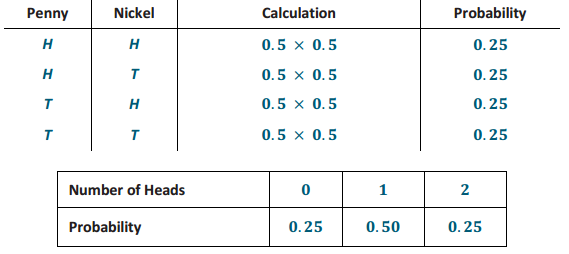
Exercise 2.
Explain how the discrete probability distribution is useful.
Answer:
It can be used to help make predictions. For example, if the scenario presents a game where I could win a prize for guessing the correct number of heads, I would choose 1 head since the probability of only one head appearing is 0.5.
Exercise 3.
What is the probability of observing at least one head when you flip a penny and a nickel?
Answer:
The probability of tossing at least one head is as follows:
P(1 head) + P(2 heads) = 0.50 + 0.25 = 0.75
Exercises 4–6
Suppose that on a particular island, 60% of the eggs of a certain type of bird are female. You spot a nest of this bird and find three eggs. You are interested in the number of male eggs. Assume the gender of each egg is independent of the other eggs in the nest.
Exercise 4.
Create a discrete probability distribution for the number of male eggs in the nest.
Answer:
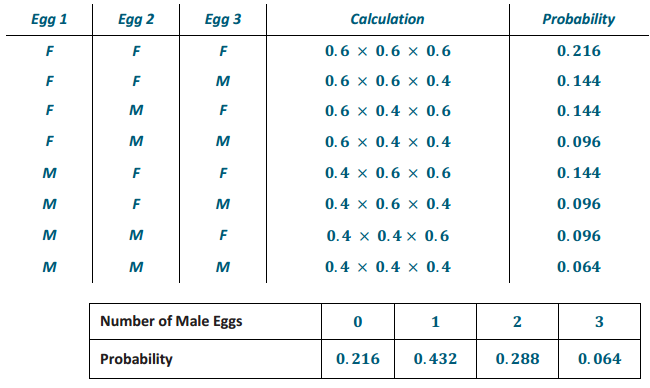
Exercise 5.
What is the probability that no more than two eggs are male?
Answer:
The probability that no more than two eggs are male is as follows:
0.216 + 0.432 + 0.288 = 0.936
Exercise 6.
Explain the similarities and differences between this probability distribution and the one in the first part of the lesson.
Answer:
The distributions are similar because the events are independent in both cases, so the probability of each outcome can be determined by multiplying the probabilities of the events. The distributions are different because the number of values for each of the random variables is different.
Exercise 7.
The manufacturer of a certain type of tire claims that only 5% of the tires are defective. All four of your tires need to be replaced. What is the probability you would be a satisfied customer if you purchased all four tires from this manufacturer? Would you purchase from this manufacturer? Explain your answer using a probability distribution.
Answer:

Note: D stands for “defective,” and ND stands for “not defective.”

To be a satisfied customer, 0 tires would be defective. The probability of this happening is 0.814 506 25.
Answers will vary about whether students would purchase tires from this manufacturer, but this could lead to a discussion about whether this probability is “good enough.”
Some sample discussion points:
81% is fairly high, but that means that there is a 19% chance that at least one tire is defective.
According to this model, about 1 in 5 cars is expected to have at least one defective tire.
Going further: Why is the probability for a vehicle to have at least one defective tire so much higher than the 5% defect rate? Is the advertised defect rate of 5% misleading?
Eureka Math Precalculus Module 5 Lesson 9 Problem Set Answer Key
Question 1.
About 11% of adult Americans are left-handed. Suppose that two people are randomly selected from this population.
a. Create a discrete probability distribution for the number of left-handed people in a sample of two randomly selected adult Americans.
Answer:
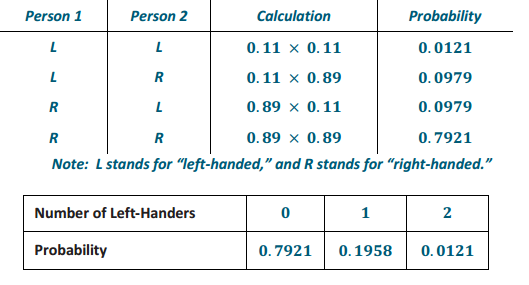
b. What is the probability that at least one person in the sample is left-handed?
Answer:
The probability that at least one person is left-handed is as follows:
0.1958 + 0.0121 = 0.2079
Question 2.
In a large batch of M&M candies, about 24% of the candies are blue. Suppose that three candies are randomly selected from the large batch.
a. Create a discrete probability distribution for the number of blue candies out of the three randomly selected candies.
Answer:
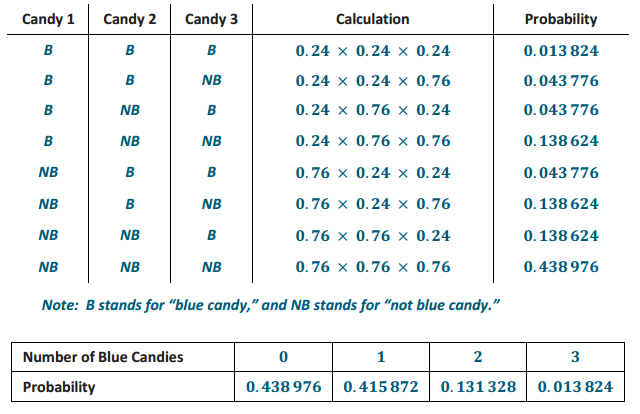
b. What is the probability that at most two candies are blue? Explain how you know.
Answer:
The probability that at most two candies are blue is as follows:
0.438 976 + 0.415 872 + 0.131 328 = 0.986 176
Question 3.
In the 21st century, about 3% of mothers give birth to twins. Suppose three mothers-to-be are chosen at random.
a. Create a discrete probability distribution for the number of sets of twins born from the sample.
Answer:
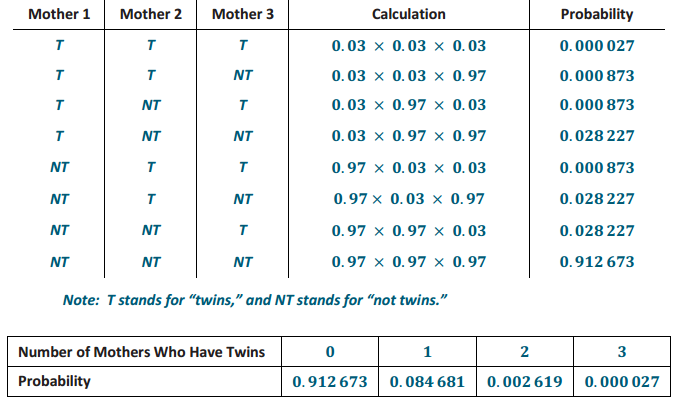
b. What is the probability that at least one of the three mothers did not give birth to twins?
Answer:
0.912 673 + 0.084 681 + 0.002 619 = 0.999 973
Question 4.
About three in 500 people have type O-negative blood. Though it is one of the least frequently occurring blood types, it is one of the most sought after because it can be donated to people who have any blood type.
a. Create a discrete probability distribution for the number of people who have type O-negative blood in a sample of two randomly selected adult Americans.
Answer:
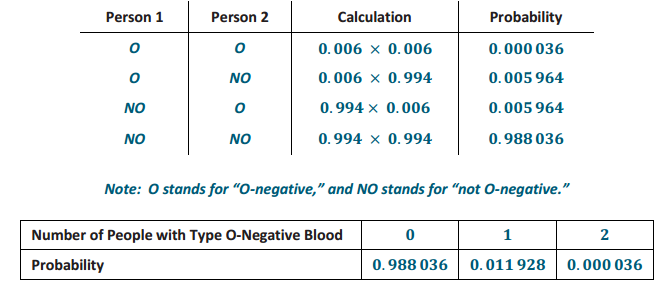
b. Suppose two samples of two people are taken. What is the probability that at least one person in each sample has type O-negative blood?
Answer:
(0.011 928 + 0.000 036)2 = 0.000 143
Question 5.
The probability of being struck by lightning in one’s lifetime is approximately 1 in 3,000.
a. What is the probability of being struck by lightning twice in one’s lifetime?
Answer:
(0.000 333)2 = 0.000 000 111
b. In a random sample of three adult Americans, how likely is it that at least one has been struck by lightning exactly twice?
Answer:
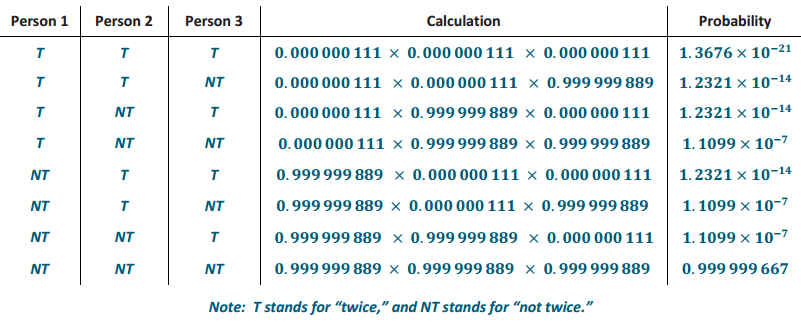

The probability that at least one person has been struck exactly twice by lightning is as follows:
3.3297 × 10-7 + 3.6963 × 10-14 + 1.3676 × 10-21 = 3.329 700 37 × 10-7
Eureka Math Precalculus Module 5 Lesson 9 Exit Ticket Answer Key
Question 1.
Suppose that an estimated 10% of the inhabitants of a large island have a certain gene. If pairs of islanders are selected at random and tested for the gene, what is the probability that one or both islanders are carriers? Explain your answer using a probability distribution.
Answer:

The probability that one or both islanders are carriers is as follows:
0.18 + 0.01 = 0.19